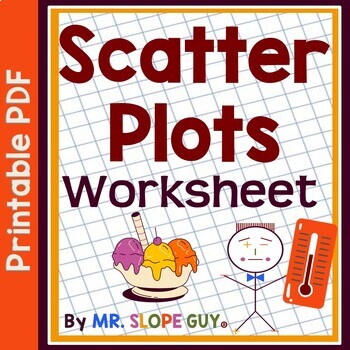Scatter Plots Statistics Worksheet 8.SP.A.1
- PDF
What educators are saying
Also included in
- Six math worksheets and one quiz targeting widely tested state math standards focusing on Bivariate Data concepts including Scatterplots and Two-Way Tables, Relative Frequency Tables and Residuals. Each include a printable PDF, Five include corresponding Easel Activities.WorksheetsScatterplots WorksPrice $14.99Original Price $19.40Save $4.41
Description
Hello, Amazing Educators! Ready to transform scatter plots from a math challenge to a thrilling adventure? Our Interactive Scatter Plot Worksheet is here to make learning a breeze and turn your classroom into a hub of critical thinking and problem-solving excitement!
Why Choose Our Interactive Worksheet?
- Engaging and Interactive: Say goodbye to dull lessons! This two-sided worksheet is packed with interactive elements that keep students hooked. From constructing and interpreting scatter plots to spotting patterns and mastering the art of the line of best fit – every step is a new adventure!
- Critical Thinking Galore: Foster critical thinking skills effortlessly. Our worksheet encourages students to analyze, question, and connect the dots (literally!) as they navigate the world of scatter plots.
- Versatile for Middle School: Tailored for middle school Pre-Algebra and Algebra 1 classes, this worksheet seamlessly integrates into your curriculum. Whether it's homework or classwork, the versatility of this resource ensures it fits perfectly into your teaching plan.
- ⏰ Easy for Teachers, Exciting for Students: Download today and experience the joy of hassle-free teaching. The easy-to-use format makes your job smoother, while the engaging content makes learning exciting for your students.
Don't miss out on the chance to transform your classroom into a hub of scatter plot excitement. Download now and let the math adventure begin!
Compatibility
For optimal use, I highly recommend printing this resource. While digital tools can be incredibly useful in many contexts, some of the questions in this resource involve tasks that are best completed with pencil and paper. Printed versions of the resource provide students with the physical space they need to work through these tasks and fully engage with the material.
Instructional Math Video
In order to provide the best possible learning experience for your students, I've included a QR code link to a video that I created to assist with using this worksheet. While the video is not professionally produced, it can be an incredibly helpful tool for students who are learning remotely, were absent during the activity, or are homeschooling. Additionally, it can serve as a substitute lesson plan in case of unexpected absences or classroom disruptions.
The video includes several examples and provides step-by-step instructions that can help students complete the activity successfully. By offering this additional resource, we hope to provide your students with the support they need to master the concepts covered in the worksheet.
Math Standards
Aligned with common core math standards 8.SP.A.1, 8.SP.A.2, HSS-ID.B.6 Construct and interpret scatter plots for bivariate measurement data to investigate patterns of association between two quantities. Describe patterns such as clustering, outliers, positive or negative association, linear association, and nonlinear association. Florida's B.E.S.T. math standards: MA.8.DP.1.1 Given a set of real-world bivariate numerical data, construct a scatter plot or a line graph as appropriate for the context. MA.8.DP.1.2 Given a scatter plot within a real-world context, describe patterns of association. MA.8.DP.1.3 Given a scatter plot with a linear association, informally fit a straight line.
Check out my other Worksheets:
Line of Best Fit Practice Worksheet
Two Way Tables Statistics Worksheet
Correlation Coefficient Matching Worksheet
Mr. Slope Guy
Teacher Feedback
"I loved this resource! It asked a variety of questions about scatter plots and lines of best fit."
"Good worksheet to have students explain information in a scatterplot that they made. Really liked that kids could (see examples) using the QR code. Planned on using just ran out of time. Maybe next year."
"This worked great for my small group that I coteach with in 8th grade. This helped me reteach the concept in a way for my students to better understand what they are learning in the general education setting."
LICENSING TERMS: This purchase includes a license for one teacher only for personal use in their classroom. Licenses are non-transferable, meaning they cannot be passed from one teacher to another. No part of this resource is to be shared with colleagues or used by an entire grade level, school, or district without purchasing the proper number of licenses. If you have any questions, please contact me at MrSlopeGuy@gmail.com.
COPYRIGHT TERMS: This resource may not be uploaded to the internet in any form, including classroom/personal websites or network drives, unless the site is password protected and can only be accessed by students.






